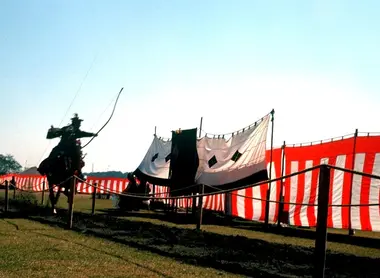Yabusame, archery of the gods 流鏑馬
Japanese Cupids
This ritualized martial art, which involves an archer on horseback, was once part of the strenuous training of the samurai. It mixes both Zen and chivalrous values, and is still practiced at some Shinto ceremonies.
While the practice of archery is very old in Japan, and gave birth to the art of Kyudo ("the way of the bow"), this is a resurgence of fighting on horseback from the Heian period(794-1185), which gave birth to the mounted Japanese archers. A discipline that requires great skill, balance and concentration.
To completely master archery on horseback for all his samurai, the shogun Minamoto no Yoritomo imposed at the beginning of the Kamakura period (1185-1333) a new type of training. Yabusame: Equipped with arrows without a point, his cavalry galloped along a track 255 meters long, aiming, during this frantic race, for three wooden targets arranged at regular intervals.
The popularity of this archery technique rapidly grew to become a ritual. Jinmu, the legendary founder of Japanese archery has always been a symbol of power and control to the Japanese.
Learn Yabusame with Voyagin.
The arrow and the gods
A religious ritual, which seeks to curry favor with the gods: if the archer hits the target, the harvest will be good!
As with many Japanese martial arts, Yabusame is full of Zen Buddhism and Shinto spirituality. It aggregates precepts and values that are important to both zen minimalism (concentration, refinement) and bushido, the samurai code of honor, which also appeared at the same time as mounted archery.
During their apprenticeships, Zen precepts are taught archery to perfect their mastery of body and mind in battle. Participating in this ritual was a great honor ... sometimes too great: its importance was such that many samurai killed themselves by seppuku - suicide by disembowelment - because of a poor performance.
An immortal ritual
With the gradual disappearance of civil wars and the arrival of firearms on Japanese soil, the practice gradually lost its popularity in the sixteenth century.
But now two famous schools, Ogasawara Ryu and rival Takeda ryu, continue the tradition of Yabusame. A set of rules, compiled in the "Yabusame-shahou," allowed the transmission of ancient principles of this martial art, seen as an expression of Japanese martial refinement.
Yabusame is still practiced during various religious ceremonies. One of the largest is held annually in April by the Takeda ryu school in Kamakura (one hour from Tokyo) in the sanctuary Tsurugaoka Hachiman-gu. These dramatic events draw crowds came to admire the prowess of archers or revive the traditions of the golden age of the samurai.

















